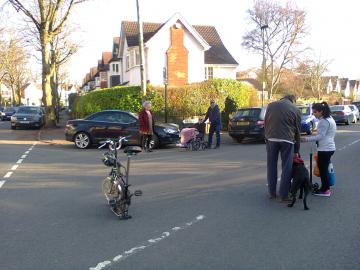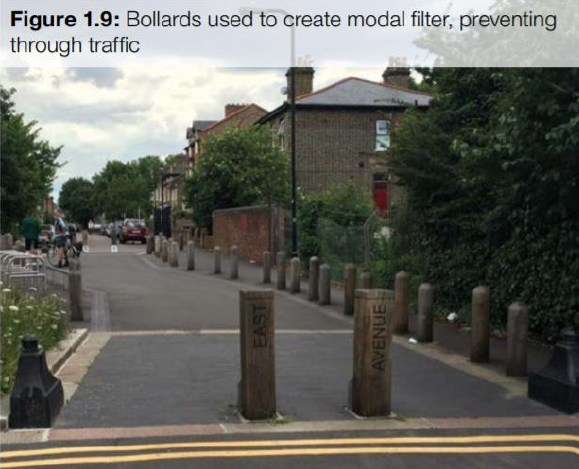
Opened 29 September 2021. Closes 5 November 2021.
The stated overview of this consultation is:
“Places for People in Kings Heath and Moseley aims to reduce traffic in residential neighbourhoods so that it is safer for people to walk and cycle, and nicer to be outside for children to play and neighbours to chat. In many parts of Birmingham, residents find their streets are busy with traffic, particularly when people are taking shortcuts to avoid main roads. When traffic is reduced the neighbourhood becomes quieter, the air is cleaner, and streets feel safer. The principle of Places for People is that residents can continue to drive onto their street, have visitors, get deliveries, etc, but it is made harder to drive straight through the area.”
The proposed designs within this consultation have multiple elements, of which the majority are directly related to cycling infrastructure and amenity and fall within the scope of this response.
The primary design element is the creation and modification of several “Low Traffic Neighbourhoods” (LTNs), also known as Active Neighbourhoods or Liveable Neighbourhoods. An LTN is a selection of side roads from which motor vehicle through traffic (rat-running) has been prevented though the use of “modal filters” (e.g., planters, bollards, no entry restrictions etc). This results in the motor traffic that is travelling through the area sticking to the main roads; creating a network of safe cycling routes on the side roads within the LTNs. This aligns with current Cycle Infrastructure Design Guidance Local Transport Note 1/20 which states:
“The simplest, cheapest interventions can be the most effective.
Perhaps the single most important tool to promote cycling may be the humble bollard, used to prevent through traffic. It is relatively inexpensive and can be erected quickly. With a Traffic Order in place to restrict use of the road by motor traffic, such low-cost modal filters can increase safety by reducing through traffic, while retaining cycle and pedestrian access. Provided they have real effect, swift, pragmatic interventions are preferred over elaborate and costly ones.”

Other design elements in the proposals include one-way roads allowing cycling contraflow, a new cycle route on Billesley Lane, a bus gate on Addison Road and new crossing facilities.
The proposals present two different design options for existing LTNs to the west of Kings Heath High Street, Options A and B; and two different design options for new LTNs to the east of Kings Heath High Street, options C and D.
All options are presented on the consultation website as a series of plans; there is an additional useful document provided by Birmingham City Council titled Design Notes that gives detailed rationale for the various elements involved.
Push Bikes completely supports the proposed LTNs and their broad layout as an important and effective way to provide cycling infrastructure and enable more active travel in Birmingham. The proposal accords with a number of Birmingham City Council’s strategic goals:
- Birmingham Cycle Revolution
- Birmingham Transport Plan
- Local Cycling and Walking Infrastructure Plan (LCWIP)
- Route to Zero climate emergency targets
- Fit for the Future Childhood Obesity Strategy
The evidence of the effectiveness of LTNs across a number of different measures is well known and tested. This response will not list all the benefits and supporting evidence for LTNs; readers may refer to previous Push Bikes Blog posts for our opinion on the topic:
Further to our support for the broad layout of the LTNs, Push Bikes has decided not to express a particular preference on the questions of “options A or B” and “options C or D”. Local residents are best placed to speak to the benefits of the various granular design details. Our overall support for the proposals would not be significantly affected by the option choice, as long as the broad layouts are implemented.
However, we would like to draw Birmingham City Council’s attention to considerations that are important in respect of some elements of the design:
- Regarding the proposed one-way loops on Valentine and Poplar Roads, the design notes includes the following rationale: “Creates a loop with Poplar Road for ease of access (no need to U-turn), facilitating traffic to the school” and “The one-way loop is from Poplar Road to Valentine Road so school children do not need to cross the road when being picked up or dropped off (car door is adjacent to the school instead of on the opposite side of the road)” Push Bikes is concerned that facilitating motor vehicle traffic to Kings Heath Primary School (a non-selective school with a small catchment area) is the opposite of the intentions of the overall scheme and intersecting strategic policies and targets detailed above. We are also concerned that the amount of motor vehicle traffic that may be attracted to this loop will make contraflow cycling dangerous and limit modal shift. We recommend that serious consideration is given to a design with a modal filter placed at the junction of Valentine Road and the A435. This will future proof that junction to be improved for walking and cycling access to the new train station and Queensbridge School.
- The bus gate on Addison Road is welcome to provide a quieter cycling route into Kings Heath from the east. We ask that the design of the bus gate takes in to account cycles and buses passing through it simultaneously, so that an unsafe “pinch-point” is avoided.
- Contraflow cycling on one-way roads is valuable and welcomed (see LTN1/20 para. 4.2.88). We require that all contraflow cycling be provided in accordance with Cycling Infrastructure Design guidance LTN1/2 section 6.4.
- Some traffic calming elements are suggested; if poorly designed, these can have a negative effect on cyclists by creating uncomfortable uneven routes or creating pinch-points squeezing cyclists dangerously close to motor vehicles. Elements such as speed bumps can also have a negative impact on cycles such as tricycles and cargo bikes, with a tipping effect. Any traffic calming must be designed to ensure cycle users are not impeded and that users of non-standard cycles are not discriminated against.
- We request that the main roads bordering the LTNs are considered for cycle lanes/tracks and traffic calming (with the same caveat above) including speed cameras to progress towards an integrated cycling network that is safe, coherent, direct and comfortable.
In conclusion; these proposals accord with the overall values of Push Bikes and are an important step in the ongoing work to achieve more cycling in Birmingham. 8 4.2.8 To make cycling an attractive alternative to driving short distances, cycle routes should be at least as direct – and preferably more direct – than those available for private motor vehicles. Permitting cyclists to make movements prohibited to motor traffic, allowing contraflow cycling, and creating links between cul-de-sacs to enable cyclists to take the shortest route, should be the default approach in traffic management schemes and new road networks. Area-wide schemes and new developments can enable filtered permeability, allowing cyclists and pedestrians to take more direct routes than motorised traffic.


